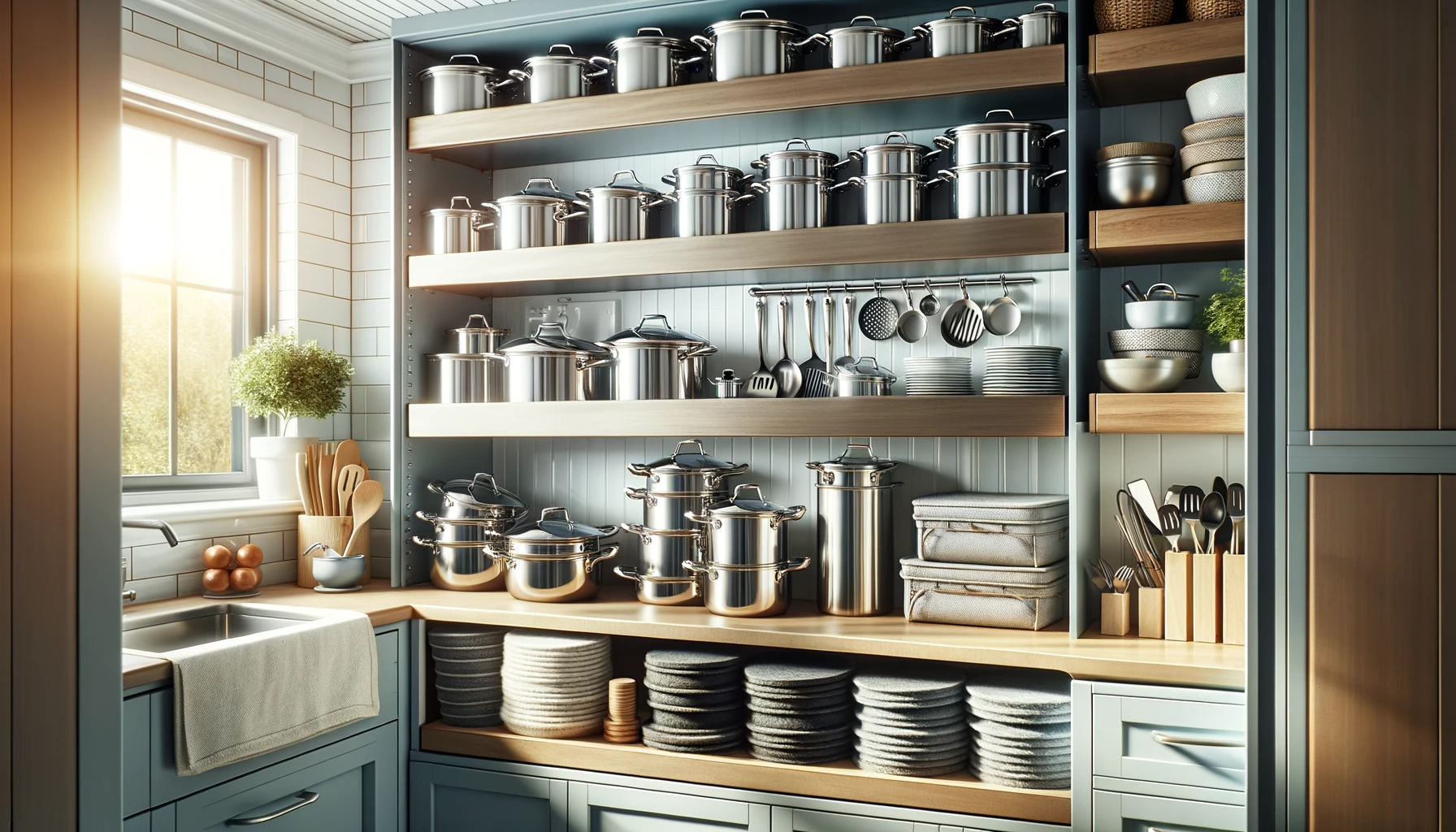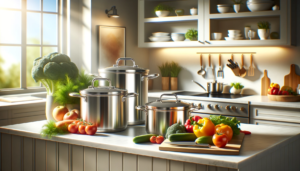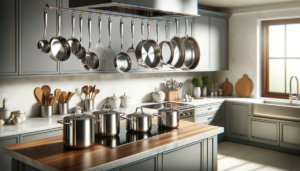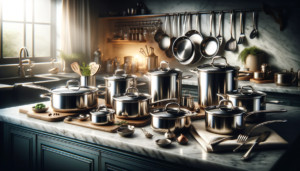Do you cringe looking at the scratched, warped, stained mess that used to be your shiny stainless steel pots and pans?
Improper storage can accelerate wear and tear, but there are simple solutions for protecting your cookware investment.
By implementing temperature regulated spaces, padded separations and strategic organizers, you can have your stainless steel cookware looking brand new for a lifetime.
Let’s explore some pro tips for storage success!
How to Store Stainless Steel Cookware
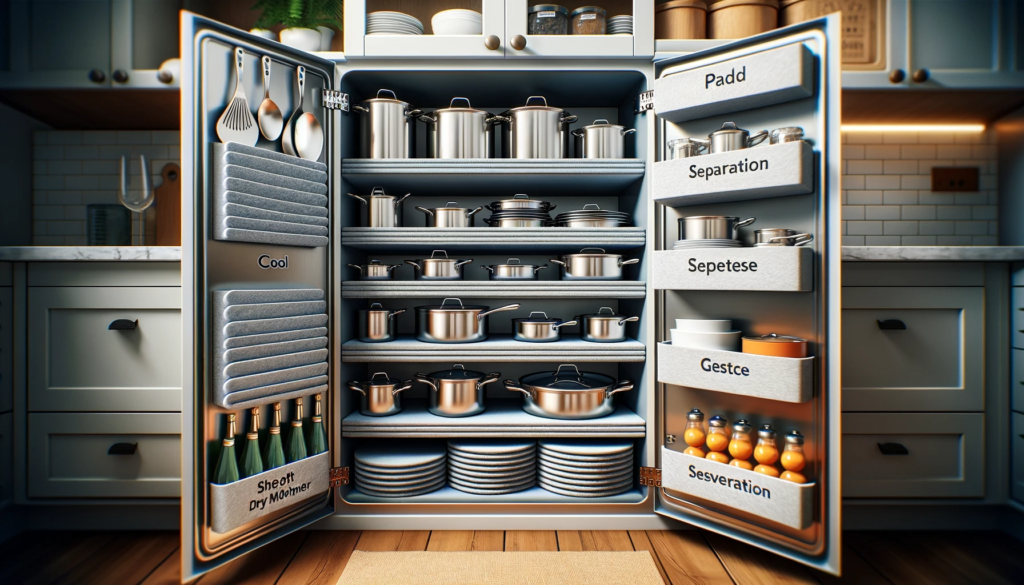
To properly store stainless steel cookware for maximum longevity, keep it in a cool, dry place like a cabinet away from heat and moisture.
Use padding like felt protectors in between stacked pots, pans and lids to prevent scratches and abrasions.
Avoid nesting non-identical metals tightly together, which can lead to warping.
Clean thoroughly after each use to prevent residue buildup that causes corrosion over time.
Store oversized or heavy cookware using padded hanging storage to save shelf space.
Finally, inspect for damage regularly and separate compromised pieces to protect the unblemished cookware.
Following these careful storage practices preserves the appearance and cooking performance of stainless steel.
Proper Storage Is Critical for Preserving Stainless Steel Cookware Long Term

Taking thoughtful steps to store stainless steel cookware properly in between uses is one of the most critical things you can do to protect your investment long term.
Letting pots, pans and bakeware items sit randomly on countertops or nesting all pieces together in a crowded cupboard might seem harmless.
However, those practices actually set the stage for exterior damage over time.
Issues like scratches, dents, warping and corrosion can gradually take hold on stainless steel surfaces that aren’t adequately protected in storage.
And while a few surface abrasions here and there may not seem like a big deal initially, collectively they can add up to impact the overall appearance, lifespan and cooking functionality of your once beautiful pots and pans.
No one wants to see their prized stainless steel cookware become riddled with scratches or take on a rainbow patina before its time.
By putting a bit more thought into how and where you store stainless steel cookware in your kitchen, you can prevent unnecessary damage due to environmental factors or improper stacking and nesting.
Taking those protective steps lets you enjoy flawless performance and gorgeous good looks for decades before having to replace items.
Check out the storage tips below for keeping every piece in your collection looking shiny and new from year to year.
Store in Cool, Dry Locations Away from Heat and Moisture
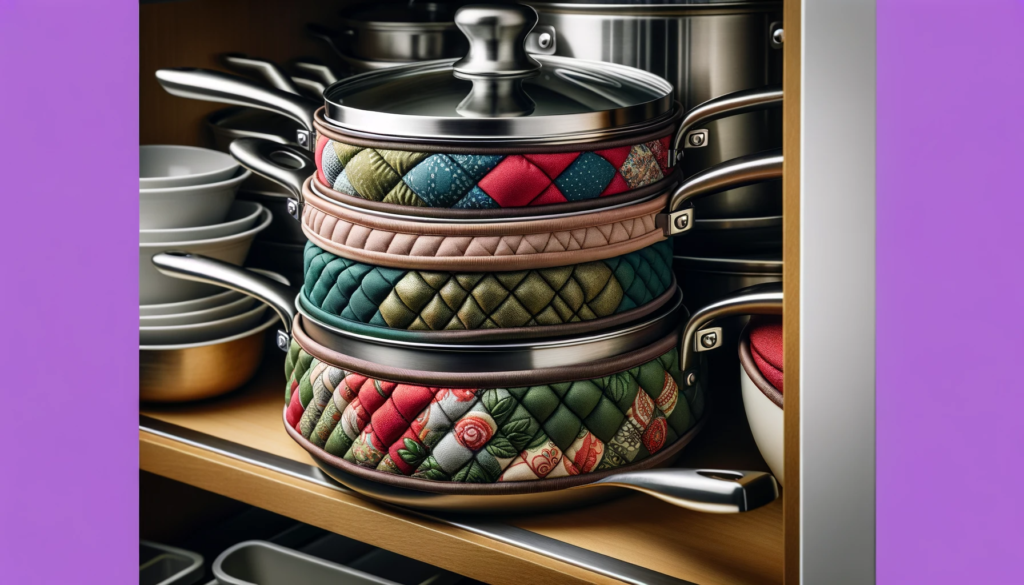
One of the key rules for storage success with stainless steel cookware is keeping it in cool, moisture-controlled spaces between uses.
While stainless steel is more rust and corrosion resistant than some other metals, it is still vulnerable to breakdown over time when exposed to condensation, humidity or drastic temperature fluctuations.
Moisture allows corroding elements to take hold and put micro holes in stainless steel surfaces.
Heat accelerates this damaging process even further.
To best preserve stainless steel cookware when it’s not being actively used, store it in a temperature and humidity controlled environment like a pantry, cupboard or drawer.
Make sure the storage space is not located directly next to heat emitting appliances like the oven, stove or dishwasher which can warp and alter stainless steel properties.
Also avoid storing cookware below sinks or water pipes where leaks could expose them to moisture damage over time.
Ideal storage spaces keep ambient temperatures moderately regulated between 60-80 degrees Fahrenheit without much fluctuation.
Well constructed wood, laminate or solid surface cabinetry helps buffer stainless steel cookware from temperature extremes and excess moisture for long term protection.
Just make sure cabinet interiors stay dry and cookware is not crowding shelving or drawers in a way that traps heat or moisture.
With proper temperature and humidity controlled storage, your stainless steel will stay in flawless shape for maximal longevity.
Prevent Scratches and Warping by Avoiding Nesting Cookware Together
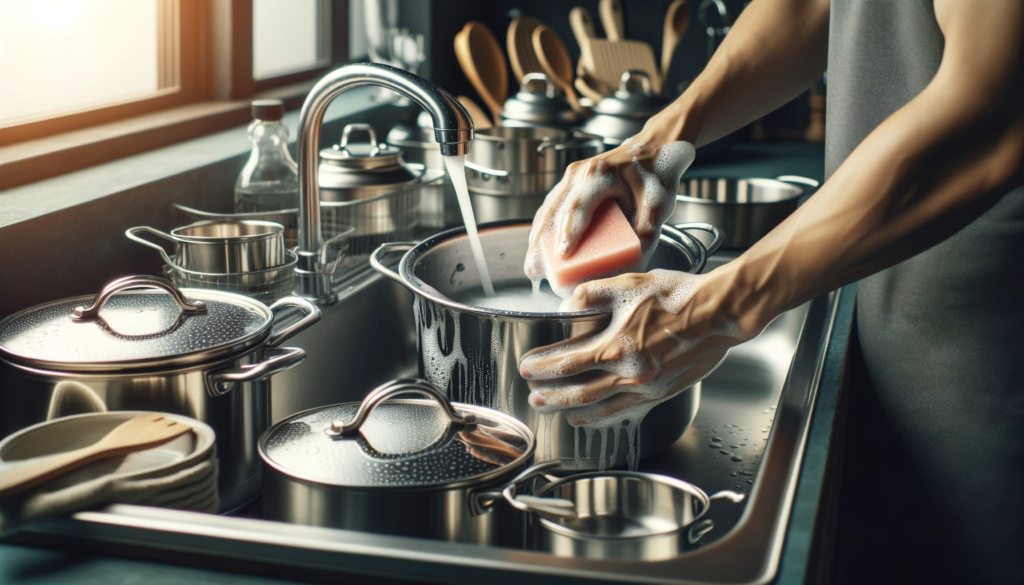
When it comes to stacking and storing stainless steel pots, pans and lids, the advice is consistent from experts… don’t nest non-identical pieces together.
While it might seem convenient to maximize cabinet space by tightly nesting everything, this practice can actually damage stainless steel over time.
Nesting cookware together puts pressure on exterior surfaces which inevitably leads to scratches, abrasions and dings.
Every time you remove a piece, the action of pulling metal across metal grated the surfaces.
These micro and macro marring collect on bases, sides and rims over years of repeated use.
While a few isolated scratches are unavoidable, collectively they degrade aesthetics and performance.
Additionally when metals of different grades and finishing processes make direct contact for prolonged periods, chemical reactions can occur leading to further exterior damage.
For example, nesting a new stainless steel stock pot inside an older pan can potentially create micro spots or discoloration on one or both surfaces.
The abrasive nature of like metals stacked together is unavoidably harsh over time.
To prevent scratches and exterior damage when storing stainless steel cookware, avoid nesting non-identical pieces directly together.
Instead opt for tools like pots and pan organizers, separate racks or interleaving items with parchment paper or folded kitchen towels.
While these protective barriers may take up a tiny bit more room than tightly stacked cookware, it’s worth sacrificing some space to keep exteriors damage-free over the long run.
Use Padding and Pot Protectors to Avoid Surface Damage
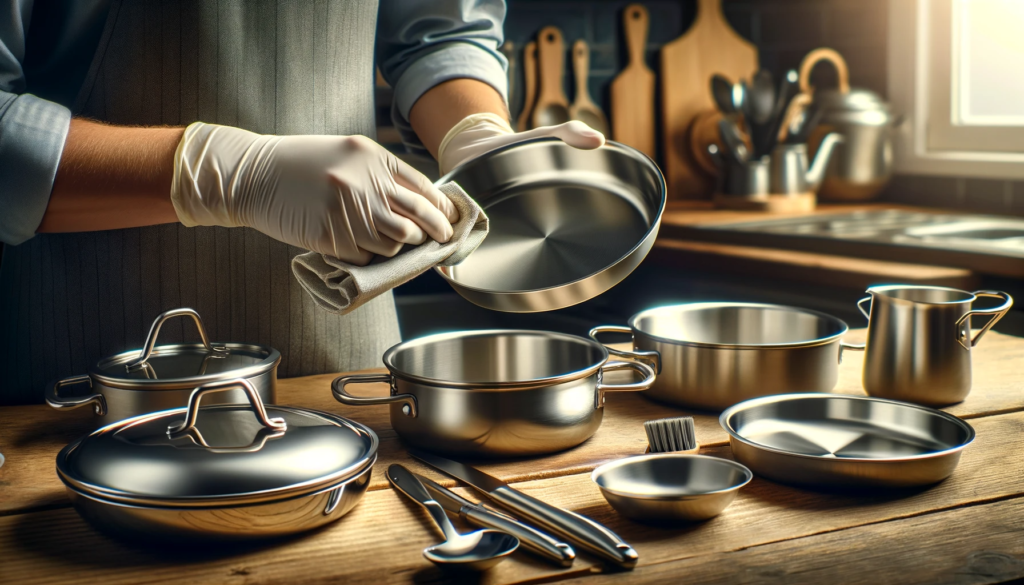
For serious stainless steel storage, pot and pan protectors should become your best friends.
These padded accessories provide a protective barrier between stacked cookware to prevent direct surface-to-surface contact leading to abrasions, scratches and scuffs.
Protectors made of materials like quilted fabric, felt or foam fit snugly between pots, pans and lids of all shapes and sizes while not in use.
Quality stainless steel pot and pan protectors have durable structures and fabrics to provide long term protection against bumps and grinding.
Felt in particular offers thickness and density that’s protective while still being gentle on surfaces.
The smooth, non-abrasive material of felt creates a “no slip, no scratch” barrier even when cookware pieces shift against each other during storage.
This helps preserve flawless stainless steel finishes so products maintain both beauty and optimal cooking functionality.
Some pot and pan protectors even fold or collapse when not protecting cookware for convenient, compact storage.
Investing in some protective padding for your prized stainless steel collection is guaranteed defense against scratches and exterior damage over time.
Clean Thoroughly Before Storage to Avoid Staining and Corrosion
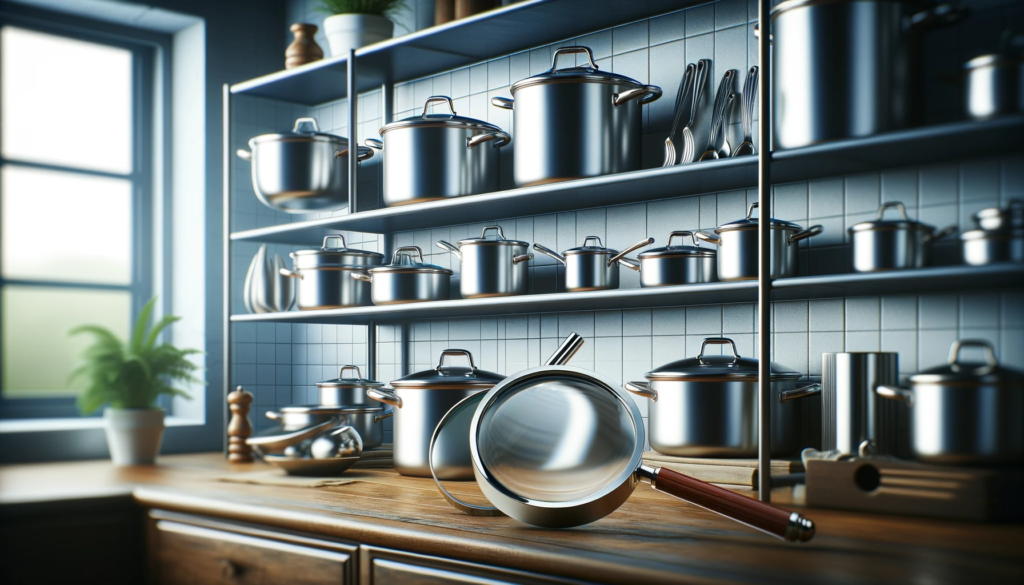
It’s imperative stainless steel cookware gets washed thoroughly after every single use before being stowed away.
Food residue, oils, spices, salt and other particle compounds left clinging to cookware allows staining, odors and corrosion to take hold over time.
For example, the salty, acidic nature of compounds found in foods like tomatoes or vinegar can damage stainless steel surfaces.
Even drying oils from fingerprints that accumulate on handles and rims can become sticky grime layers that permanently stain.
To prevent staining, odors and corrosion damage on stored stainless steel, be diligent about cleaning practices.
After cooking, allow cookware to cool then wash thoroughly in hot soapy water using either a cloth or non-abrasive sponge.
Carefully scrub inside surfaces, handles and lids to lift all stuck on residue.
Follow with a clear water rinse before immediately hand drying with a clean towel.
Ensure cookware is 100% dry both inside and out before stowing away.
Taking the time to properly clean stainless steel cookware keeps particles from interacting with and breaking down stainless properties whenever sits idle.
Regularly Inspect Cookware for Early Signs of Damage
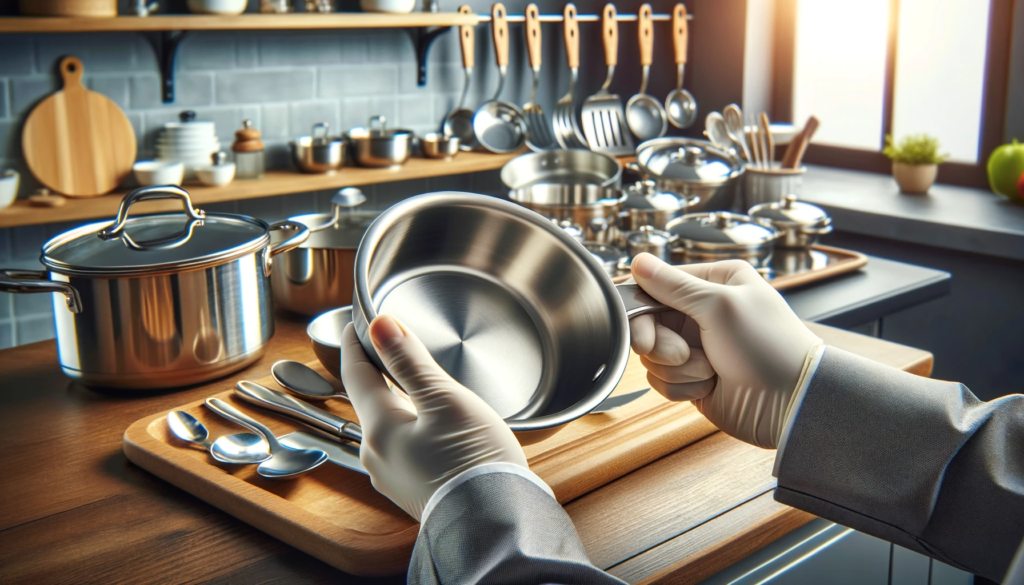
Be proactive about occasionally taking stock of stored stainless steel cookware specifically looking for early signs of damage.
Periodically inspect for issues like scratches, dents, warping, corrosion spots, discoloration or staining on both interior and exterior surfaces.
It’s much easier to repair minor damage right away versus letting it escalate over neglectful years of storage.
Focus inspections on the undersides of cookware pieces which rarely get viewed yet take the brunt of scratches from pulling on and off shelves.
Also check areas around handles, pour spouts and rims which can collect debris leading to staining.
If you notice light corrosion or scratching, immediately hand wash the piece again.
For more aggressive damage, use a stainless steel cleaner and extra fine scrubbing pad to try and minimize blemishes.
While scratches can’t fully be removed, early intervention prevents them worsening over time.
For pieces with damage beyond shallow scratches, consider taking them out of circulation for storage.
Putting already compromised stainless steel cookware back into stacked storage will simply aggravate issues further.
Anytime you notice new dings or excessive scratches, stop storing those problem pieces with your pristine stainless steel collection.
Don’t risk allowing damaged cookware to deteriorate your other pieces through shared storage contact.
Isolate and replace problem items as needed.
Utilize Hanging Storage for Large, Bulky Pieces to Save Shelf Space

An excellent storage solution for oversized or heavy stainless steel cookware pieces like stock pots, steamers or giant skillet lids is utilizing hanging storage.
Wall mounted pot racks, ceiling hooks or under cabinet lid racks are great space saving options in lieu of cramming oversized items onto shelves.
Hanging bulky stainless steel cookware helps open up cabinet and drawer space for nicer organizational options for all the other pieces in your collection.
However don’t just hang your prized pots and pans from basic hooks that can damage exteriors over time.
Instead opt for storage hooks that have protective padding integrated to cradle cookware without scratching.
Quality lid racks also have padded, non-slip pegs that won’t mar surfaces.
Using these safe hanging storage tools, even the heaviest stock pot or giant pasta pentola finds a home off shelves with less risk of scuffs.
Arrange pots and lids neatly above the stove for quick access while freeing up storage real estate below for protecting everything else.
With hanging storage, ensure pots have helper handles in tandem with the main loop handle so the weight distribution stays balanced once lifted off hooks.
You don’t want all that hefty cookware crashing down onto countertops or floors.
Safety first! Use this vertical storage technique thoughtfully and you can securely coral unwieldy yet indispensable oversized stainless steel pieces.
By Caring for Stainless Steel Cookware, It Will Care For You Too
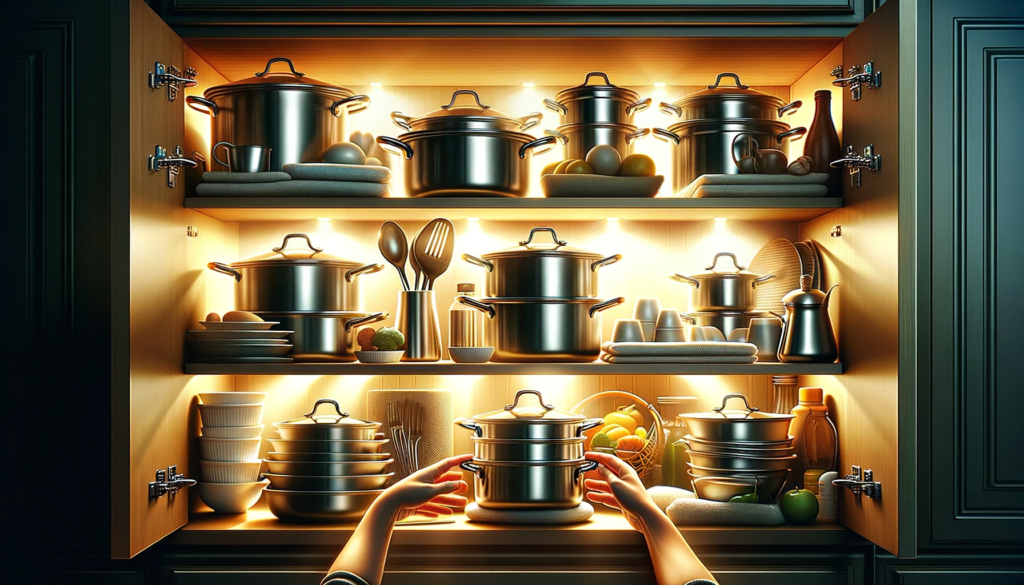
By now it should be clear that stainless steel cookware doesn’t fare well long term without thoughtful care including storage between uses.
Taking extra steps to store pots, pans and bakeware properly truly pays back over time by keeping exteriors damage-free so they continue delivering like-new cooking performance for decades.
The harmless looking stack of dirty pots by the kitchen sink or the overstuffed cookware cabinet might seem convenient.
However letting stainless steel pieces mindlessly bang together through improper storage invites dings, abrasions and corrosion issues over time.
By putting in dedicated effort to protect your stainless steel cookware, it will in turn protect you through flawless cooking experiences for years on end.
Conclusion
Properly caring for stainless steel cookware by implementing thoughtful storage methods helps preserve appearances and cooking functionality for decades.
Save your investment from unnecessary damage by storing cookware in cool, dry spaces with padding between stacks.
Separate damaged pieces and utilize vertical hanging storage to keep oversized items from monopolizing cabinets.
Show your stainless collection a little TLC through protective storage practices and it will reliably meet all your cooking needs for years to come.
